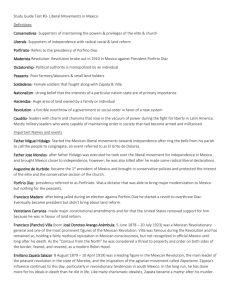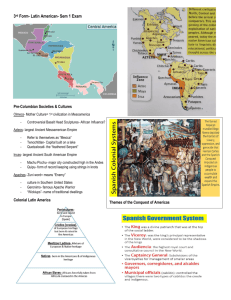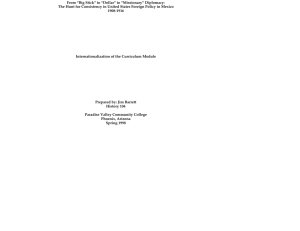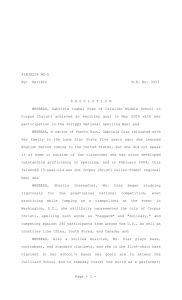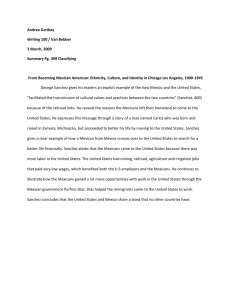CIENTIFICOS: CRITICS OF THE DIAZ REGIME, 1892-1903
advertisement
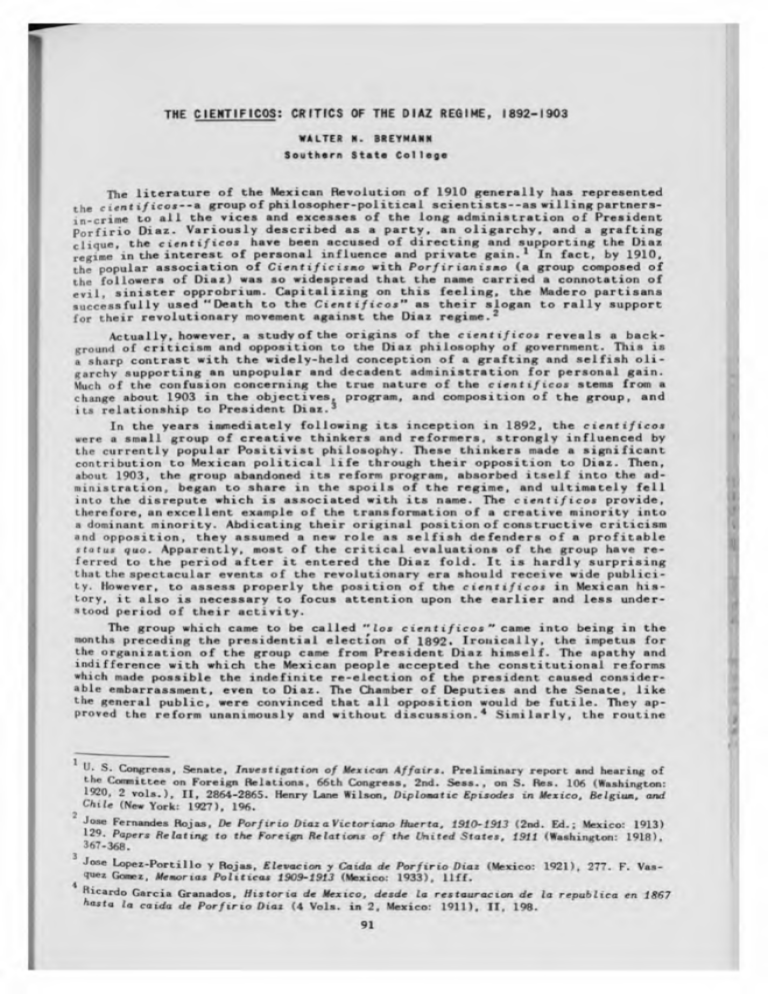
THE CIENTIFICOS: CRfTfCS OF THE DIAZ REGIME, 1892-1903 WALTER N. 8REYMANN Southern State College — The literature of the Mexican Revolution of 1910 generally has represented of philosopher-political scientists as willingpartnersthe cientificos--a group in-crime to all the vices and excesses of the long administration of President as a party, an oligarchy, and a grafting Porfirio Diaz. Variously described clique, the cientificos have been accused of directing and supporting the Diaz 1 regime in the interest of personal influence and private gain. In fact, by 1910, with (a group composed of association of Cientificismo Porfirianismo popular the the followers of Diaz) was so widespread that the name carried a connotation of evil, sinister opprobrium. Capitalizing on this feeling, the Madero partisans successfully used "Death to the Cientificos" as their slogan to rally support 2 for their revolutionary movement against the Diaz regime. Actually, however, a study of the origins of the cientificos reveals a background of criticism and opposition to the Diaz philosophy of government. This is a sharp contrast with the widely-held conception of a grafting and selfish oligarchy supporting an unpopular and decadent administration for personal gain. Much of the confusion concerning the true nature of the cientificos stems from a change about 1903 in the objectives, program, and composition of the group, and 3 its relationship to President Diaz. In the years immediately following its inception in 1892, the cientificos were a small group of creative thinkers and reformers, strongly influenced by the currently popular Positivist philosophy. These thinkers made a significant contribution to Mexican political life through their opposition to Diaz. Then, about 1903, the group abandoned its reform program, absorbed itself into the administration, began to share in the spoils of the regime, and ultimately fell into the disrepute which is associated with its name. The c ientificos provide, therefore, an excellent example of the transformation of a creative minority into a dominant minority. Abdicating their original position of constructive criticism and opposition, they assumed a new role as selfish defenders of a profitable status quo. Apparently, most of the critical evaluations of the group have referred to the period after it entered the Diaz fold. It is hardly surprising that the spectacular events of the revolutionary era should receive wide publicity. However, to assess properly the position of the cientificos in Mexican history, it also is necessary to focus attention upon the earlier and less understood period of their activity. " " The group which came to be called los cientificos came into being in the months preceding the presidential election of 1892. Ironically, the impetus for the organization of the group came from President Diaz himself. The apathy and indifference with which the Mexican people accepted the constitutional reforms which made possible the indefinite re-election of the president caused considerable embarrassment, even to Diaz. The Chamber of Deputies and the Senate, like the general public, were convinced that all opposition would be futile. They approved the reform unanimously and without discussion. 4 Similarly, the routine S. Congress, Senate, Investigation of Mexican Affairs. Preliminary report and hearing of the Committee on Foreign Relations, 66th Congress, 2nd. Sess. , on S. Res. 106 (Washington: 1920, 2 vols.), II,2864-2865. Henry Lane Wilson, Diplomatic Episodes in Mexico, Belgium, and Chile (New York: 1927), 196. Jose Fernandes Rojas, De Porfirio Diaz aVictoriano Huerta, 1910-1913 (2nd. Ed.; Mexico: 1913) 129. Papers Relating to the Foreign Relations of the United States, 1911 (Washington: 1918), U. 2 367-368. Jose Lopez-Portillo y Rojas, Elevacion y Caida de Diaz (Mexico: 1921), 277. F. VasGomez, Memorias Politicas 1909-1913 (Mexico: Porfirio 1933), llff. nicardo Garcia Granados, Historia de Mexico, desde la restauracion de la republica en 1867 hasta la caida de Porfirio Diaz (4 Vols. in 2, Mexico: 1911), II,198. quez 91 ARKANSAS ACADEMY OF SCIENCE 92 manner in which Diaz was re-elected in 1888 without the slightest legitimate opposition became something of a scandal. Still, Diaz was anxious to impress foreigners with Mexico's progress in democratic government. 5 Consequently, as the elections of 1892 approached, Diaz felt that there should be at least a semblance of political activity. According to plan, this political activity would give rise to popular approval of his candidacy. He wanted it to appear that he was not forcing his own return to office entirely through his power as chief executive. " The president's first attempts to manufacture" a controlled political activity and an expression of popular enthusiasm were unsuccessful. The efforts of the Junta Central Porfirista, banquets in the national capital for jefes politico and municipal alcaldes , and suggestions that the press propagandize in the president's behalf, failed to generate the desired enthusiasm. Failing in these attempts, Diaz was forced to organize a movement more political in nature. He accepted a suggestion of Rosendo Pineda, secretary to the Minister of Gobernacion, that Diaz employ a convention like those used in the United States to nominate a presidential candidate. Recalling the failure of earlier attempts, Pineda and the supporters of Diaz decided to launch the new maneuver under a new name. A new organization, known as the Union Liberal, was created. Clubs were organized in many municipalities of the Republic, and they prepared for a national convention to open in Mexico City, April 5, 1892, to designate Porfirio Diaz as the candidate of the Liberal Party. 9 On April 19, 1892, the convention dutifully nominated Diaz as its candidate but, significantly, it went on to name a commission to draw up a political program for the Union Liberal Convention. The convention's provisional president, Manuel Maria Zamacona, revealed the reformist temper of the group when he announced in his opening address that basic changes were needed in the pattern of Mexican government. Although aware of the auspices under which the convention met, he openly announced that true liberalism could not remain passive and inactive. "Despocism grows," he asserted, "from the inertia of [political] parties and the apathy and indifference of the people..." 10 Democracy could exist, he argued, only when "... expression of the national will through freedom of the press, freedom of assembly, and effective suffrage..." are assured. 11 In keeping with this note, a program was presented to the convention April 23, 1892, and approved. It was formulated by and carried the signature of 11 men. Five of these-- Justo Sierra, Rosendo Pineda, Pablo Macedo, Jose Limantour, and Francisco Bulnes-- became the nucleus of the cientif icos The formulators of the program envisioned reform along several lines. 13 They sought to improve the administration of justice in the republic by making the tenure of judges permanent and to prevent removal of the judges on the whim of the chief executive. 14 They proposed that the press be allowed to express political opinion, and they wanted this freedom stated in definite and liberal terms so that writers would know their political limitations. They urged the adoption of a new method of presidential succession, in the event of a temporary or permanent absence of the chief executive. This part of the plan was the origin of the establishment of a Mexican vice president. Diaz had opposed consistently . 5 Henry Lane Wilson, "Errors with Reference to Mexico and Events That Have Occurred There," Annals of the American Academy of Political and Social Science, LIV (1914), 148. Ramon Prida, De la dictadura a la anarquia; Apuntes para la historia politico de Mexico durante los ultimos cuarenta y tres anos (El Paso, Texas: 1914), 94. Garcia Granados, Historia de Mexico, II,199 201. Prida, Dictadura a la anarquia, 95 8 Ibid., 95. Garcia Granados, Historia de Mexico, II,201 10 Ibid., 202-203. 11 Ibid. 12 Luis Cabrera, Obras Pol iticas del Lie. Bias Urrea: Recopilacionde escritos publicados durante los anos de 1909, 1910, 1911, y 1912 (Mexico: 1921), 382. Lopez, Elevacion y caida, 260. 13 Cabrera, Obras politicas, 377-382. Garcia Granados, Historia de Mexico, II,252. Prida, Dictadura a la anarquia, 97. t CRITICS OF THE DIAZ REGIME 93 presidency. The final proposal of the Union Liberal advothe creation of a vice of popular education, freedom of commerce from internal ated the development • strictions, and economy in the national administration. The public was surprised at the frankly democratic ideas contained in the Liberal. The need for reform was evident, and it also was manifesto of the Union suppressed any manifestation of individual initiative that evident that Diaz had and liberal system. Clearly, the program represented the sought a democratic work of men whose political ideas contrasted sharply with those of the government of Diaz. While Diaz accepted the proferred nomination with alacrity, he announced in his inaugural address December 1, 1892, that he planned no significant changes Minister of Hacienda in his cabinet or in his policies. When Jose Limantour, ' (Finance), was asked to present the cientificos program to the president, he could getISno assurance from Diaz that the president would consider the reform program. Despite this lack of official encouragement, the originators of the reform program, with Justo Sierra as their spokesman, presented their proposals to the Chamber of Deputies October 30, 1893. Insisting that the time had come to convert into reality the plans and promises of the convention, Sierra proposed that the Chamber turn its attention first to the proposal concerning an independent judiciary.16 During the month of debate in the Chamber, the press aired the matter the proposals fully. Though the "great mass of the country remained ' In these inert," discussions, the same aroused intense interest in government circles. small group which had planned the program of the Union Liberal party was the backbone of its defense. Finally, December 4, 1893, the Committee on Justice and Constitutional Points recommended the adoption of the measure. " The name "cient ifico originated during these debates. It was coined, and probably used derisively, by an opponent of the program. 18 In answering an objection of the opposition, Francisco Bulnes stated that the proposals had been prepared after a scientific investigation of the matter. To this statement, the rejoiner was that the members of the group, then, considered themselves "cientificos." The name became more popularly and widely applied as the group continued20to insist that scientific principles be applied to the problems of governAdministration, they insisted, should not be merely pragmatic, but should ment. follow the dictates of political science. Pleased with the name, the cientificos used the word science constantly. Government was to be scientific. The administration of finances was to be scientific; everything was to be scientific. The public, hearing the same word continually repeated, came to refer to them as c ientificos 2 l At the conclusion of the debate, the judicial reform measure was passed in the Chamber, December 12, 1893 and immediately sent to the Senate. Too little time remained for the Senate to act on the measure before the close of the session and it was left pending as unfinished business. At the next session, President Diaz ordered the matter shelved, and it was not acted on until the time of Madero. 22 Here, finally, was an obvious manifestation of the fundamental differences between Diaz and the c ientificos. It was clear that their program of reform did not carry unqualified official approval, even though it had been the result of a convention called with the express consent and approval of Diaz. Thus Diaz dismissed the initial attempt to bring a democratic application °f scientific principles to government problems. The failure, in this instance, . Lopez, Elevacion y caida, 259. Garcia Granados, Historia de Mexico, II, 252-253. Andres Molina Enriquez, Los Grandes Problemas Nacionales 18 Investigation of Mexican Affairs, I, 771. Cientifico" is used 2 here in the sense of Cabrera, Obras Politicas, 16. 1 Lopez, Elevacion 22 Prida, Dictadura y caida, a 261. la anarquia, 101. a (Mexico: 1909), 306. man learned in any branch of knowledge. T ARKANSAS ACADEMY OF SCIENCE 94 did not efforts. On the contrary, proof of the mark the end of the cientificos' sincerity of the cientificos at this stage lies in the fact that they continued the struggle in spite of the formidable opposition of the president. From this point until 1903 the cientificos were forced to promote their program and exercise their influence outside the administration. Except for one of their number, Jose Limantour, Minister of Hacienda, they had no direct contact with the government. Diaz did not yield to their influence, nor were they simply creatures of Diaz, as often is assumed. 23 He refused them any public or official recognition during this period and called on rival groups to promote his re-election in 1896 and in 1900. 24 The fact that Diaz encouraged the public to blame the cientificos for their many dissatisfactions, is an indication that no close political cooperation existed between them at this time. 2 Looking for a scapegoat, Diaz chose the cientificos He charged they had fomented popular unrest by talking of reform and criticizing his procedures. Others took up the cry and the term cientif icos became little more than a convenient tool for disparaging enemies. Although the cientificos never were organized formally as a political party, though erroneous references to them as a partido do exist, it is possible to establish2 with some accuracy the principle members of the group during its early period. The composition of the group changed from time to time, but during its years of critical opposition to Diaz, 1892-1903, the years when its contribution to Mexico's social and political thinking was greatest, the group was small and select with probably no more than 15 members. 2 " What has been called the "Partido Cient ifico was simply a small group of Mexican intellectuals who had associated themselves with some of the original leaders of the Union Liberal convention of 1892. They were associated by conviction rather than convenience and held together by their belief that the wellcapacity and being of the country depended on the development of its productive 'This coterie, prothe improvement of its government along scientific lines. *" . " gressive and intent, attracted others of similar caliber. They were men of exceptional ability, and they were able to exert an inEven their enemies admitted that fluence out of proportion to their numbers. they were men of unusual talent, constituting a social force of great power and 31 regime. intellect in the old " As opponents of Porf irianism, the cientificos placed their trust in la ciencia" and visualized scientific government and development under the guidance of a talented oligarchy, as contrasted with government under the personal tyranny of a caudillo. 32 23 Ibid., 108. Ibid., 104. Manrique Moheno, Partidos Politicos, Estudio Sobre suviabilidad ynaturaleza de sus funciones en la Republica Mexicana (IWexico: 1910), 146. Prida, Dictadura a la anarquia, 105. 26 Trinidad Sanchez Santos, Editoriales de "ElPais" en 1910, 1911, y 1912, compiled by M. S. Sanches (Mexico: 1923), 317. 2^ Cabrera, Obras Politicas, 19. Roque Estrada, La Revolucion y Francisco I.Madero (Guadalajara: 1912), 25. Carlo de Fornaro, Mexico tal qual es (International Publishing Company: 1909), 123-130. Francisco I. Madero, La Sucesion Presidencial en 1910 (3rd. ed. ; Mexico: 1911), 25. Investigation of Mexican Affairs, I, 771. 28 See Ibid., I,773, II,2864; Cabrera, Obras Politicas, 6ff; Fornaro, Mexico tal qual es, 125. Despite the controversy involved in seeking to determine the peripheral membership of the group, it is clear that the word as originally used by the Mexican people applied primarily to the following men who were responsible for leading and directing the movement during the early or creative period: Jose Ives Limantour, Justo Sierra, Francisco Bulnes, Pablo Macedo, Miguel Macedo, Emilio Pementel, Rosendo Pineda, Joaquin D. Casasus, and Manuel Zamacona. 29 Moheno, Partidos Politicos, 146. 30 Investigation of Mexican Affairs, II,2255. Mariano Cuevas, Historia de la Nacion Mexicana (Mexico: 1940), 1013. Roque Estrada, La Revolucion yFrancisco I.Madero, 31. See the concept of the "creative minority" as developed in Arnold J. Toynbee, A Study of History (6 vols.; London: 1934-1939), III,239ff. 31 Cabrera, Obras Politicas, 3,8. Fornaro, Mexico tal qual es, 125 32 Cabrera, Obras Politicas, xv. 24 CRITICS OF THE DIAZ REGIME 95 Distinctly Positivist in ideology, the "ciencia" to which they turned was philosophy of August Comte. The majority of the cient ificos were maintained its hold on owed Positivists and through their influence Positivism of Mexico during the Porfirian Era. 33 Under the spell of Comte, the mind-life Mill, and Durkheim, they sought to usher in a new era of scientific Spencer, rosress based upon the application of the methods and discipline of the natural sciences to the solution of pressing social and political problems. The man who brought Positivism to Mexico was Gabino Barreda. In 1848 he had Mexico, he eone to Paris and in 1849 had attended Comte 's classes. Returning to »as instrumental in establishing in 1867 the National Preparatory School along Inheriting his enthusiasm, Barreda's students, :he lines of Comte's ideology. including the c ientificos , were convinced that Positivism alone could replace The original manifesto 36 of the Union Liberal anarchy with scientific progress. Viewed in the light in 1892 was the work of distinguished students of Barreda. the Positivist of this philosophical orientation, it is easier to understand their sincere insistence that science was the key to Mexico's future. The attitude of the cientificos toward the problems of government is shown motivation, which in in their writings. These works provide insights into their ater years was open to serious question. Basic to all c ient ifico belief was their constantly reiterated faith in science and efficiency. The writings of lusto Sierra and Manuel Flores, like the original manifesto of the Union Liberal, are replete with tributes to science as the force which could accelerate Mexican progress. 37 uninterSecond only to their belief in science was their desire to maintain " rupted peace for Mexico. Francisco Bulnes, often mentioned as the high priest of Mexico," 'ositivism in gave frequent and eloquent expression to this desire in lis public speeches. 38 Peace was so earnestly desired by the " cientificos that it religion was almost a with them. Only the fact that the Porfirian Peace" of )iaz had made possible a measure of political stability induced the cientificos to resign themselves to certain aspects of the status quo. The continuation of this stability was indispensable if Mexico expected to progress and consolidate 39 its gains. Hoping that the dictatorship would be merely transitional, they were persuaded to accept Diaz as the only alternative to anarchy. This decision, >ased on the best of motives, later opened the cient ificos to widespread criticism in the revolutionary era and made them appear to be simply lackeys of the dictator. As a corollary to their beliefs in science and political stability, the cientificos wanted to promote Mexico's material development. In a sense, their faith rested in a type of progress that could be measured by the output of mines and factories and the mileage of railway and telegraph lines. Actually, their thinking was based upon a more visionary and farseeing ideal. Mere industrialization was only a stepping stone to national economic independence and freedom, expression is given to this facet of their ideology in the works of Justo Sierra: "Colonization, labor and capital to exploit our great riches, means of transportation to enable wealth to circulate, these were merely the social desiderata; what was important was for the Republic to pass from the military to the industrial stage of its development, and to make the passage quickly, for the giant who was growing at our side [the United States] was coming toward us... The weak have never been free. "40 Samuel Ramos, Historia de laFilosofia en Mexico (1st. ed. ;Mexico: 1943), 124. Leopoldo Zea, El Positivismo en Mexico (Mexico: 1943), 171-173, 177, 186. Antonio Caso, Mexico, Apuntanientos de Cultura Patria (Mexico: 1943), 76. Irma Wilson, A Century of Educational Thought (New York: 1941), 225. 3 Ramos, Historia de Filosofia en Mexico, 119. J° •. • El Positivismo, 186. Justo Sierra, Evolucion Politico del Pueblo Mexicano (Mexico: 1910), 414. See the" Manifesto" of the Convencion Nacional Union Liberal quoted in the appendix to Cabrera, Obras Politicas, iZea, 7_- fir. ¦ ,„.- 379. For a full account of this Ibid., 250. iQ Sierra, speech see Lopez, Elevacion y Caida, 249-253. Evolucion Politica, 416, 458. ARKANSAS ACADEMY OF SCIENCE 96 Thus, to Sierra and the cientificos , industry alone was not enough. To them, industrialization and material progress meant strength, and strength meant freedom. They persuaded themselves that a peaceful Mexico under Positivist development could acquire the strength to protect itself from its neighbor on the north. Another aspect of cientifico ideology is revealed in an essay by another of the original cientificos , Miguel Macedo, in which he outlines the respective "In society," says Macedo, "all inobligations of the various social classes. dividuals have a determined role or position which determines their relation with others. The superiors, by virtue of their intellect, position, leadership, and resources, should work for the benefit and the progress of society. The inferiors, on the other "hand, should follow and not impose resistance to the activities of the leaders. Here is a disturbing attempt to justify the cientificos in their self-appointed role as an oligarchy of talent and intellect and as a directing minority in charting Mexican progress. This class conscious creolism, which would delegate to the mestizo and the Indian a secondary role of accepting and supporting the Positivist program of material development, caused the cientificos to be hated passionately in later years. The first Union Liberal convention in 1892 and the second in 1903 were both creole-dominated. In many respects the cientiexpression of a not uncommon Latin American desire ficos represent the ultimate for creole supremacy. 42 In their impatience to achieve a material and scientific Utopia, they were led to depreciate and disparage the possible contribution of other elements in the Mexican nation, including its mestizo president. It is ironic that the cientificos, disciples of Barreda, should share this attitude of their class toward the native population. They viewed Mexican progress in a coldly Positivist way--a mechanistic, scientific, material development " which sometimes had to favor not all Mexicans, but only that creative minority" vanguard in the of progress. In their anxiety to build a well-governed and modernized Mexico, they succumbed to the attractive expedients of Creole control and the encouragement of foreign techniques, institutions, and capital. It became increasingly difficult for the cientificos to achieve understanding and sympathy for the common people of Mexico. This increasing emphasis on Europeanization and the ensuing lack of rapport with the masses was symptomatic of the change that was to take place in the fortunes of the cientificos after the turn of the century. This aspect of their ideology coincided more readily with the interests of Diaz, and by 1903 there was increasing evidence that the president would call off his anti-c ient ifico campaign and make use of their talents. 43 In that year he turned to the Union Liberal to promote his sixth re-election. 44 This change in the policy of Diaz toward the cient ificos is due in part to a significant change in the attitude of the cienti ficos themselves. Their critical, reforming impulses had been blocked by the dictator, and some of the cientificos forgot their original purpose, abandoned their ideal of social progress for the good of the nation, and turned their efforts to private interests. This shift in emphasis from political reform to the harmless concerns of routine business was more to the president's liking, and it explains in large measure his increasingly favorable attitude after the turn of the century. He saw them now as a group which could be useful to his administration without being a source of In a sense, this significant change in cient ifico attitude repreembarrassment. sents an accomplishment for Diaz and a defeat for the original cientifico principles. Henceforth, the cientificos might participate more fully in the government, but it would be on the caudillo's own terms. 42 43 44 " Ensayo sobre los deberes recipricos de los superiores y de los inferiores." Positivismo, 171ff. for a discussion of this essay. Molina Enriquez, Grandes Problemas Nacionales, 306. Vasquez Gomez, Memorias Politicas, 11-14. Lopez, Elevacion y Caida, 248-254. See Zea, £' CRITICS OF* THE DIAZ REGIME 97 to a merely dominant minority was soon efupon cientifico membership. The original group, to Diaz, had attracted those who shared their whose willingto support their program in the face of official oppoviews and who were sition. After the cientificos made their peace with the dictator, and began to of dominance in the government, they attracted many others, achieve a positionconviction, but because of personal convenience and ambition. who came not from this larger group of The name "cientifico" inevitably cameandto be extended tooften intrigues were credited to the opportunists whose personal affairs , original cientificos a fact that blinded many to the real nature of the earlier administration, spoils of the they inherited cientifico program. Sharing in the also the opprobrium of the discredited regime when it was destroyed by revolution less than a decade later. The transition from a creative It had a marked effect fected.ideas had been obnoxious 45 Roque Estrada, La Revolucion y Francisco I.Madero, 31.
